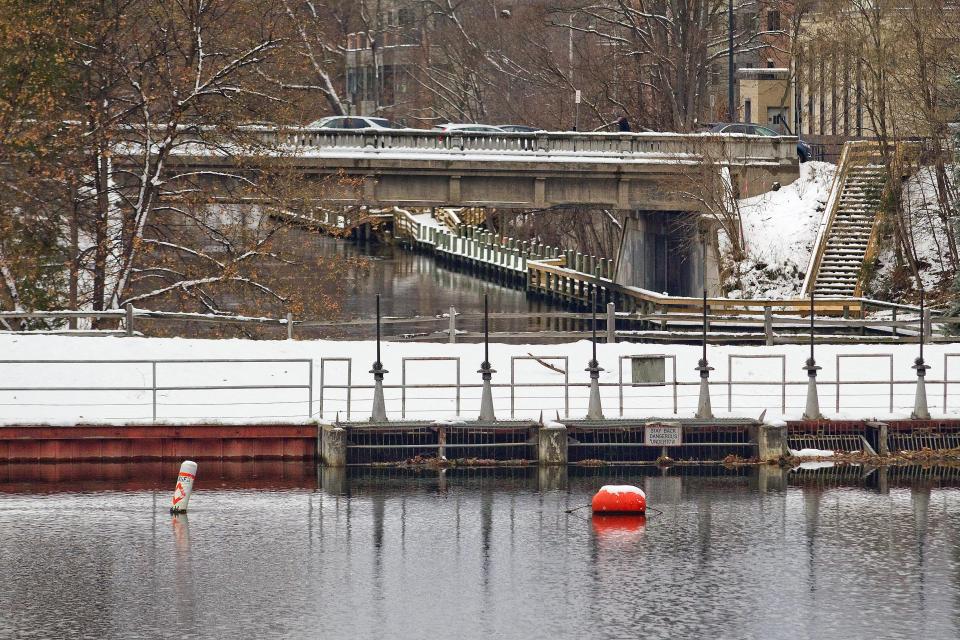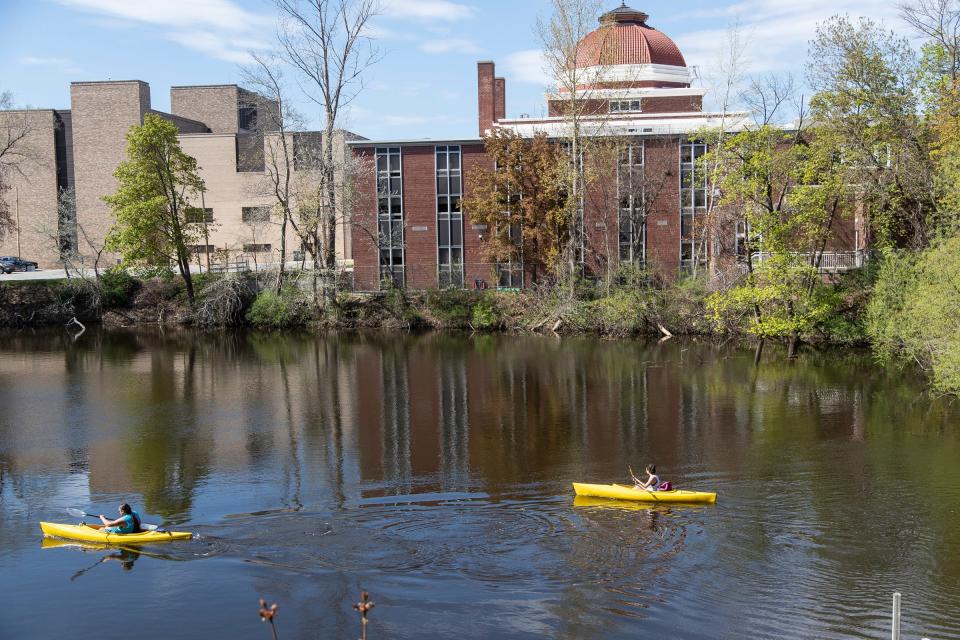Traverse City project would aid native fish while blocking invasive species
TRAVERSE CITY — A failing dam on a river winding through Traverse City could be replaced by an innovative “FishPass” that would allow native fish species to move up and downstream while keeping harmful invasive species like sea lampreys out.
The FishPass proposal is the culmination of 20 years’ worth of efforts to restore the Boardman-Ottaway River that flows into west arm of Grand Traverse Bay on Lake Michigan. But the project faces a legal challenge that has wound its way to the state Court of Appeals.
The 10-year research project would look into a variety of methods for sorting fish — using environmental stimulation like bubbles, sound, light and pheromones to herd them through the structure. Fish would then be sorted below the dam and transported upstream in a kind of elevator or pump known as an Archimedes screw, said Dan Zielinski, principal engineer and scientist with the Great Lakes Fisheries Commission and for FishPass.
Fish recognition technology
Another method would sort fish by detecting density, size, shape, color and migratory patterns. To address the problem of different fish with similar characteristics, and fish that are above or below average size and weight, FishPass plans image recognition technology, similar to the facial recognition used to unlock smartphones. It’s been used in fish studies before, but always in a laboratory setting where fish behaviors can differ from in the wild. FishPass would be the first to study this method in a natural setting.
“We're not focusing on developing new tools, but it's really using the tools that have been developed over the past 50 to 100 years and being able to integrate multiple tools in different configurations. FishPass really presents the first time that that's ever been able to be done,” Zielinski said.
The nearly $20 million project would be paid for largely through federal and state grants.
The Boardman-Ottaway River flows more than 28 miles from near Kalkaska to Grand Traverse Bay. The river once had four dams, used first for the timber industry that boomed in Michigan in the late 1800s and early 1900s, and later for hydropower generation. Three of the four dams have since been removed, part of an effort to restore more natural flows to the river. The Union Street Dam in downtown Traverse City is the last remaining dam, and the century-old earthen barrier is deteriorating.
More:As climate change alters Michigan forests, some work to see if and how the woods can adapt
More:Climate change is already hurting Michigan's cherry, apple crops — and it could get worse

Helping good fish while keeping invaders out
But the degrading structure cannot simply be removed. The Union Street Dam — the furthest downstream and closest to Lake Michigan of the four historic dams — creates nearby Boardman Lake, and is the last barrier between the river system and invasive species like sea lamprey that could threaten the ecological health of the river, prized for its trout fishing.
Enter FishPass, a collaborative effort between Traverse City and federal, state and tribal agencies. It would create a new facility about a mile upstream of the Union Street Dam, so the failing structure can be removed. It would also establish an education and research center, where a variety of methods would be tested and implemented to allow movement of desired species on the river while keeping invaders out.
“This is just the most innovative and most exciting project that I think I've seen our commission be involved in,” said Marc Gaden, deputy executive secretary for the Great Lakes Fisheries Commission.
“Part of it is because it's truly paradigm-shifting in terms of fisheries. But the other part is that it's the capstone of the restoration of the Boardman-Ottaway River that's been going on for a long time.”
More:Great Lakes heat waves are already causing chaos for fish — with worst to come
More:Michigan Appeals Court throws out cleanup order for dioxane plume under Ann Arbor

Legal disputes stand in way
An important part of the FishPass project was the recreational and aesthetic appeal of the campus. The commission incorporated features residents wanted into the design like natural aesthetics, green space, rain gardens and access for fishing and kayaking. They also did not include picnic tables or grills in the design, as requested by community members.
Getting the community on board was essential for the project, since public support determined whether it would be approved, Gaden said.
“We had kind of a dual need going on,” he said. “That dam needed to be replaced because it's leaky and old and dangerous, frankly. And we needed a place to do the technology and technique research in a very controlled setting.”
Traverse City resident Rick Buckhalter filed litigation against the city and the Traverse City commission last year, contending that the FishPass project was going to impact a public park and so should be put to a citywide vote. Judge Thomas Power of the Thirteenth Circuit Court in Grand Traverse County concurred. The city, with the support of Michigan Attorney General Dana Nessel, then appealed the decision to the Michigan Court of Appeals, with a hearing in Petoskey on Oct. 4. A decision at the appellate court is pending.
Traverse City attorney Lauren Triboe-Laucht said the city’s charter gives the commission the power to approve the project. She added that the property where the FishPass facilities will be constructed is not dedicated parkland, and the city will retain ownership of it.
Traverse City isn’t the only locale with an old, failing dam and a need to move some fish species up and downriver while keeping others out.
“The impact of invasive species and barriers is a global concern,” Zielinski said. “In our conversations with international partners and colleagues, they're all looking at this project to see what solutions are going to be generated and are quite excited about the project as well.”
Detroit Free Press reporter Keith Matheny contributed. Contact reporter Tess Ware at tware@petoskeynews.com. Follow her on Twitter, @Tess_Petoskey.
This article originally appeared on The Petoskey News-Review: Traverse City project would aid native fish, block invasive species

